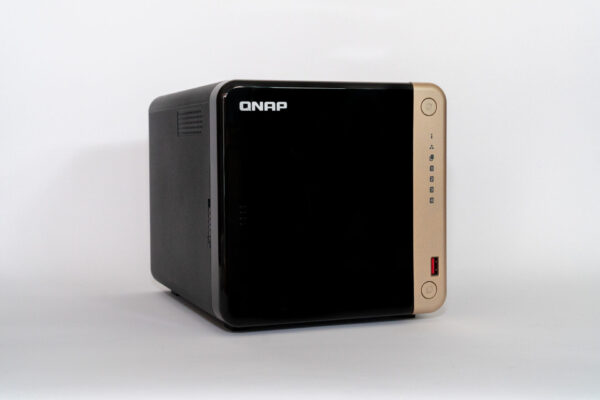
QNAP has a new prosumer NAS on the market. The new TS-x64 NAS is available in 4- or 6-bay variants (TS-464 or TS-664), and they are great options for those who are looking to own their cloud storage boxes.
I have the 4-bay TS-464 NAS for this review, and in many ways, it is an evolutionary update of the TS-453D which I reviewed last year. There are many similarities, but also at the same time, important hardware upgrades and performance improvements in the new TS-464.
Physically, the TS-464 is almost indistinguishable from the previous TS-453D. The main clue comes from the gold panel on the new TS-464, where has the TS-453D had gray panel. There are also some difference in the ports on the back. Otherwise, the box not only looks mostly identical, they are also of the same exact dimentions (168 × 170 × 226 mm) and weight (3.6 kg).
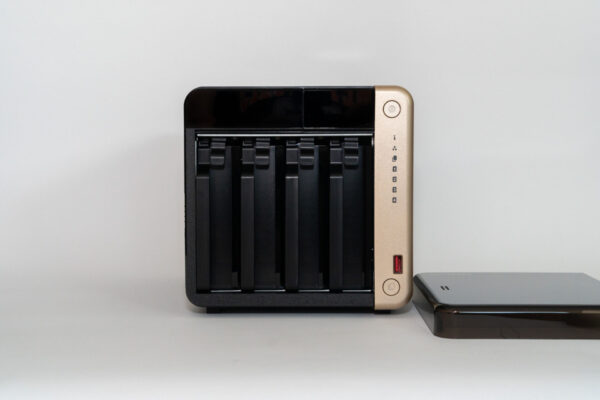
The TS-464 has four (six on the TS-664) 3.5-inch SATA 6 Gbps drive bays on the front. There is also one USB 3.2 Gen 2 (10 Gbps) Type-A port to quickly and conveniently plug in removable USB devices. The older TS-453D offered only a USB 3.2 Gen 1 (5 Gbps) port.
On the back, the TS-464 has:
- Two 2.5 GbE ports
- HDMI 2.0 port (with 4K 60Hz support)
- Two USB 2.0 ports
- USB 3.2 Gen 2 (10 Gbps) port
- Kensington security slot
- DC barrel jack
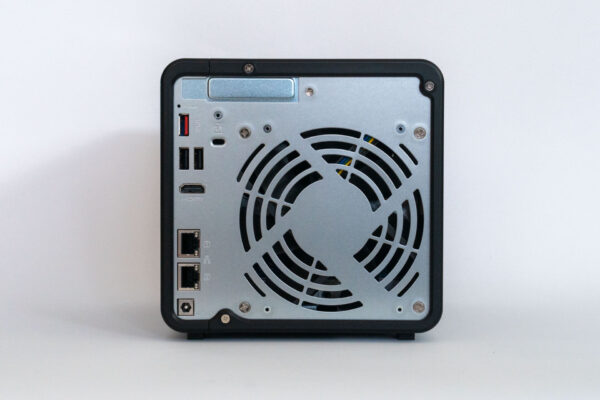
In comparison, the TS-453D has a USB 3.2 Gen 1 port in lieu of the TS-464’s USB 3.2 Gen 2 port, and adds an extra USB 2.0 port.
Both the TS-464 and TS-453D have a PCIe expansion slot. The new TS-464 offers PCIe Gen 3 x2 whereas the TS-453D has PCIe Gen 2 x2. You can install a 10 GbE network card in the TS-464 if the 2x 2.5 GbE ports onboard aren’t good enough for you!
More importantly, under the hood, the TS-464 offers not one, but two M.2 2280 PCIe Gen 3 x1 slots for NVMe storage. This means that, out-of-the-box, you can plug in a NVMe stick into the TS-464 to serve as a fast cache without having to give up one of the SATA drive bays to plug in a SSD. I know, the single lane may be a little disappointing, but I think QNAP made a good compromise with allocation of PCIe Gen 1 lanes available from the processor.
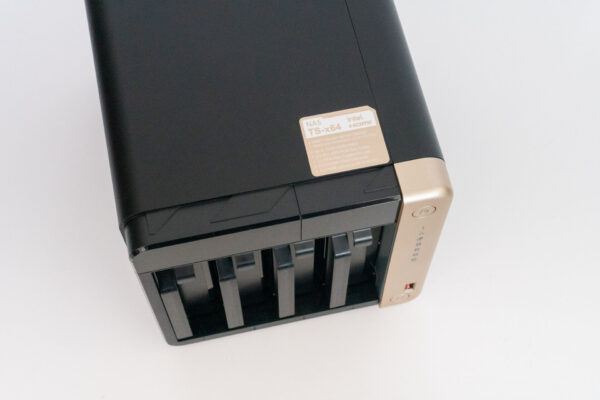
The QNAP NAS has a QTier feature that allows a single volume to be created with a mix of storage types (i.e. hard disks, SSDs, and NVMe), while intelligently moving frequently accessed data to faster storage and putting lesser use data in slower storage. You can also use the PCIe slot to attach more storage, such as even more NVMe, if you want even more speedy storage.
The TS-464 comes with 4 GB of RAM. There are two SODIMM slots, supporting DDR4 2933 MHz RAM, allowing you to upgrade total memory up to 16 GB using 2x 8 GB memory sticks. This is the officially stated spec, but yours truly will tell you that 2x 16 GB (i.e. total 32 GB) seems to work just fine. More memory is always going to be helpful if you ever decide to run one or more virtual machines on the TS-464, something that I, and I imagine some other prosumers, will very much want to do.
(Update Jan 2025: Intel’s spec used to specify max of 2x 8 GB too, but I notice they’ve since updated as 2x 16 GB.)
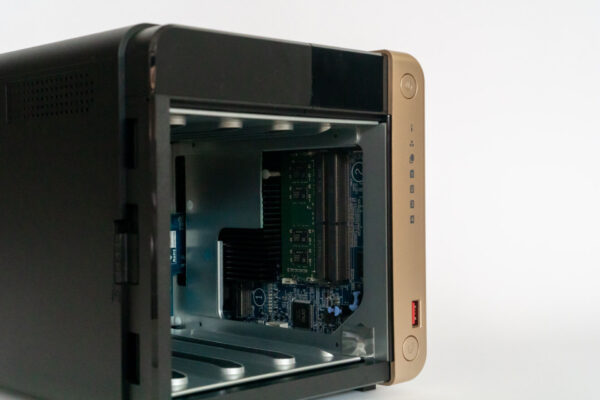
The TS-464 is powered by an Intel Celeron N5095 (or N5105) processor with 4 physical cores. This is a 15 Watt processor with a base clock of 2.0 GHz, burstable to 2.9 GHz. It also has Intel UHD integrated graphics, so out-of-the-box, the NAS is good to go as a media player connected to a TV with up to 4K 60Hz support. The processor, though designed for low-power applications, is quite capable so it can easily support some more demanding workload.
In terms of software, the TS-464 runs QNAP’s QTS which is currently at version 5.0.1. Some of the new features in QTS 5.0.1 are:
- You can now replace RAID disks before potential failture
- Free exFAT support for ARM-based NAS (the TS-464 is Intel based, so this is not directly relevant)
- Enhanced transfer speeds for SMB singing and encryption
- Windows Search Protocol (WSP) support for mounted sharef dolers
- Suports Enterprise SED (self-encrypting drive)
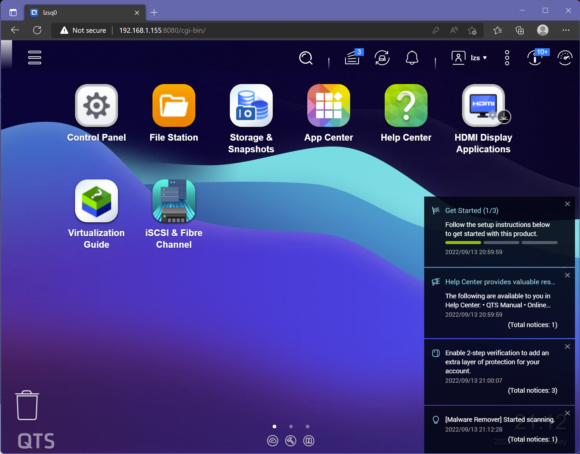
QTS is really powerful. It has all sorts of features that could be overwhelming to a novice user. Prosumers, however, will love various QTS features and applications such as:
- Hybrid Backup Sync which allows a variety of backup, one-way or two-way sync to local, remote, and cloud storage spaces. If you are serious about your backups, this software enables you to implement advanced strategies to protect your data.
- QSync which provides cloud storage services similar to OneDrive, DropBox, and Nextcloud. This gives you all the benefits that public cloud storage services can provide, but lets you own everything, while avoiding recurring storage subscription costs.
- Block-based snapshots for easy data protection and recovery.
- HybridMount which provided a virtual consolidation of various public cloud and private storage spaces into a single storage gateway.
- QVR Elite which is used for cutting-edge smart camera surveillance.
For my test use, I configured the TS-464 with a single thick volume with a bunch of shared folders accessed via SMB (Windows File Sharing). I also configured a Ubuntu 22.04 VM in the QNAP Virtualization Station which, part from a main virtual disk, NFS mounts more storage directly from the NAS’ shared folders. I also set QSync to sync folders across several of my devices. Finally, I setup backup to my existing Nextcloud WebDAV folder.
Everything works well. I did find some quirks with using encrypted volumes without storing the key on the NAS itself, as there were issues with certain backup options. I don’t want to store the key on the NAS itself since that means I have no protection against theft. Apart from this, the TS-464 performs admirably. I was able to max out the Gigabit Ethernet port on my desktop PC, and unfortunately, I did not have any computer with a 2.5 GbE port to test the TS-464 at extreme speeds.
You probably know QNAP’s main competitor is Synology. The latter’s equivalent NAS to QNAP’s TS-464 is the DS920+ which is a little dated at this time. The TS-464 is superior in every major aspect:
- Intel Celeron N5105/N5095 CPU is better than DS920+’s Intel Celeron J4125
- Intel UHD Graphics vs no integrated graphics on DS920+
- Expandable to 16GB of RAM, whereas DS920+ is up to 8 GB
- 2x M.2 PCIe Gen 3 x1 slot vs none on DS920+
- 2x 2.5 GbE ports, whereas the DS920+ only has GbE
- 2x USB 3.2 Gen 2 (10Gbps) ports vs none on the DS920+
- 1x PCIe Gen 3 x2 slot vs none of the DS920+
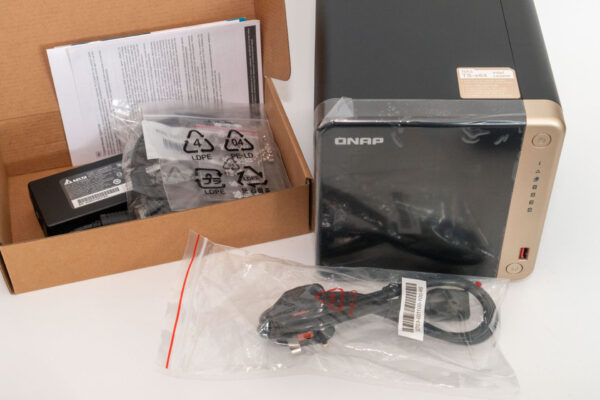
The TS-464 comes with the following items in the retail packaging:
- Power adapter and power cord
- Scews for installing hard disks/SSDs (the hard disk brackets offer toolless installation for 3.5-inch drives)
- Ethernet cable
I think most prosumers will find the TS-464 to be a great NAS to work with. It has many powerful features, and the NAS has great performance. There are many useful apps that you can install in the TS-464, turning it into not just a great cloud storage gateway, but also a feature-rich media player that you can hook up to your TV. Whatever you cannot do with an app, you can always do via virtual machines which you can run on the box.
I’ve found the TS-464 to meet most of my prosumer NAS needs. The fundamental capabilities for online network shares (e.g. Windows File Sharing) worked well and performed well. I could pretty much max out the 1 GbE that my desktop PC had, which means the network is likely the bottleneck, not the TS-464.
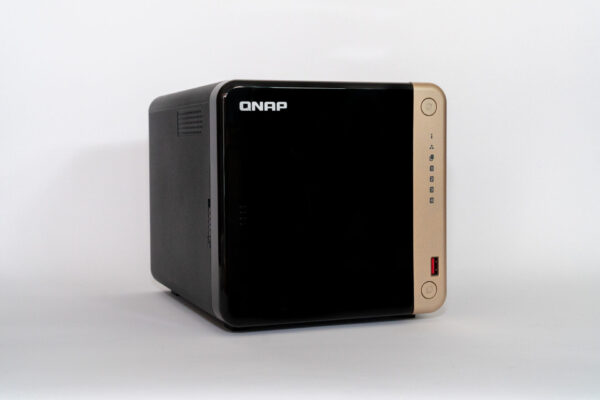
The QNAP TS-464-4G (as reviewed) retails at $929 without any drives, and you can get it from Lazada and Shopee. It comes with 3 years of local warranty. A two-bay version of the TS-x64 will be coming soon, so if you think two drives are good enough for your use, you might want to look out for its launch.
Hi,
I just got a QNAP TS-464 and am waiting for three Seagate Exos X18 18tb HDDs to arrive (they are non-SED drives). I am thinking about encrypting the main volume when I set up the NAS, but before doing so I was curious as to what sort of decrease in read/write performance should be expected? The TS-464 has an integrated Intel AES-NI encryption engine, so I am assuming this helps noticeably with improving the performance.
If it’s a minor decrease then I’ll go ahead encrypt; if it is a substantial decrease then I guess I’ll leave it unencrypted.
Cheers,
Guy.
Hi! I’m going to post separately about some benchmarks. But here’s a quick one. With 2x drives in RAID1, encrypted volume, I manage about 110 MB/s copy over Windows SMB share. I think this is pretty impressive. My test PC only has GbE, so 110 MB/s is fairly close to the limit of GbE. This was during early stage of testing, without snapshots, etc, which QNAP says will decrease performance.